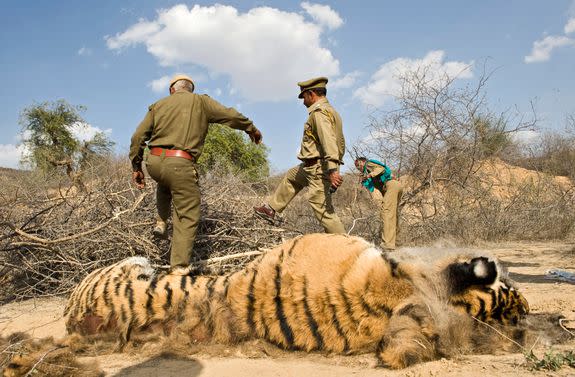A man-eating tiger is dead. And that's good for other tigers.

After killing and eating more than a dozen villagers in India over the last two years, an elusive tigress was shot dead by government-hired hunters on November 2.
Killing endangered wild tigers certainly isn't ideal, as there are only some 2,150 to 3,150 adults left in the wild, globally. But, in the unusual case that a tiger begins hunting people, it's necessary that the tiger be killed, or if possible, relocated.
The legendary cats' greater existence, in a human-dominated world, depends on it.
"When you have a tiger that’s killed 13 people, that really undermines the conservation effort," John Goodrich, a tiger biologist and chief scientist at the wild cat conservation group Panthera, said in an interview.

Image: AFP/Getty Images
This particular tigress, officially called "T-1," eluded government rangers for two years. When community members live in perpetual fear of such a powerful carnivore, they can turn against the decimated species.
"It's very easy to poison [tigers]," Anish Andheria, a large carnivore specialist and president of India's Wildlife Conservation Trust, said in a call from India. "So when you have a tiger like this, you should act immediately — so the system remains intact."
That means allowing the rare wild tigers to exist in healthy, growing numbers by feeding on wild prey, not being gradually picked off after ingesting poison-laden animal carcasses. Ideally, they live on protected, wild lands. But the furtive predators are not fenced in, so they commonly roam outside refuges and sometimes (less ideally) feed on domesticated cattle, goats, or pigs.
SEE ALSO: The EPA completely axed its climate change websites. But why are NASA's still live?
The rare rise of a man-eater, however, isn't fair to local people, many of whom have no choice but to enter tiger country.
"They are the poorest of the poor, making $150 a year maximum," said Andheria. "They live in constant fear of attack," he said, noting that they have no choice but to go outside and graze their animals.
"It's not a good feeling when staying at home isn’t an option," he added.
So the state government, Maharashtra, called in renowned wildlife hunter Nawab Shafath Ali Khan to find and dispatch the tigress with his team, the New York Times reported.
Understandably, there has been an outcry, particularly on social media. The tigress was a mother with young cubs.
"People are feeling sorry for her cubs," said Andheria. "The cubs will suffer."
It's a tough situation, he agrees. But conservation trumps other concerns.
"Animal welfare is different than conservation," Andheria emphasized. "What can you do if you have a murderer? You can’t let the murder go scot-free."
What drives a tiger to become a man-eater?
"The bottom line, there's no one thing you can pin it on," said Goodrich.
Goodrich, who spent 15 years working with tigers in Russia, captured those involved in various human-wildlife conflicts. Around 70 percent of tigers that interacted with people had some sort of injury that likely led them to act aggressively towards people, perhaps driven by hunger. The behavior of the tigress might also have been altered by an infectious disease, he noted.
Yet, with a tiger that's been killing for two years, Goodrich said such health problems are unlikely.

Image: Aditya Singh/Barcroft India / Getty Images
Still, like any animal — from wild bears to pet dogs — each tiger is different. And wildlife is inherently unpredictable.
"Occasionally some predators have individual quirks or behaviors that lead them to conflicts with humans," Sugoto Roy, coordinator of the International Union for Conservation of Nature's (IUCN) Integrated Tiger Habitat Conservation Program, said over email. "In some cases they are termed 'rogues.'"
This is especially the case when they become habituated to people, and are no longer weary of approaching humans. This may be the case with the farmer the tigress T-1 killed, even though he was surrounded by cattle.
"It is a matter of time before a tiger loses fear," said Andheria.
It's important to note that humans, who are on the smaller spectrum of tiger prey, are not nearly a reliable, meaty-enough sustenance for tigers.
"Humans are not an adequate but an easy source of prey, as they are easy to kill," said Roy.
Sometimes people get too close to tigers that are munching on livestock, which leads to a human death.
"This is how man-killing starts," added Roy.
A bright, striped future?
Most wild tigers in the world, about 65 percent, live in India, said Andheria.
"Despite having 1.3 billion people, India supports more tigers than all the other countries put together," he noted.
"To have them, in the 21st century, living alongside people is a miracle," Andheria added. "Nowhere else on Earth are large carnivores like tigers surviving in human-dominated landscapes."

Image: FLPA/REX/Shutterstock
Some of these tigers live in protected national parks and sanctuaries. But about 30 percent live in non-protected areas interspersed with farmland, as did the once-deadly tigress T-1. And tiger populations in India have been rising, in part because they rarely seek out and distress people.
"If they were predisposed to kill people, we would lose 60 or 70 people every two days," Andheria said.
The killer tigress, although taking as many as 13 lives, could have easily taken many more.
"She was probably coming into contact with people almost every day," said Goodrich.
Though the last official count in 2014 arrived at an estimated population of 2,226 tiger adults in India, there's likely room for many more striped predators.
"There is enough forest to support 5,000 to 10,000 tigers," said Andheria.
It's less certain if Indian communities will accept the spread of more tigers.
While protecting Tigers is a moral responsibility, protecting Humans is a bigger responsibility, and one that must be given preference to. The Tigress officially known as T1 was responsible for the death of 13 people in the last two years.https://t.co/TjO1YeTxCO
— Sudhir Mungantiwar (@SMungantiwar) November 7, 2018
"Biologically it is possible to hold more tigers, but socially it’s a question," he said.
Regardless of how or if the population grows, a healthy human-tiger relationship simply can't tolerate man-eaters. Maintaining a harmonious coexistence has known, realizable solutions to avoid such rare circumstances, noted Roy. This includes connecting existing patches of forest together, fencing in farm animals, and developing rapid alert systems to notify communities when tigers are nearby.
Tigers are wondrous, stalking creatures from another time — when land was untrammeled and bona fide wild predators ruled the land. Coexistence is now the only solution if both species are to endure. But coexistence doesn't just mean killing man-eaters. It means giving tigers room to be tigers.
"Tigers and people don’t get along very well," said Goodrich. "Where they overlap, tigers lose."
At least, eventually.
WATCH: Ever wonder how the universe might end?


